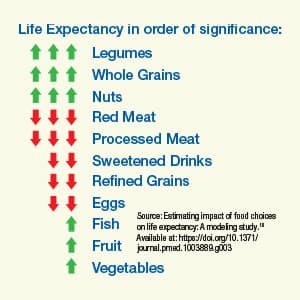Life Extension Magazine®
Healthy eating patterns have long been associated with increased human life expectancy.
A higher degree of adherence with the Mediterranean diet is associated with a 10%-42% lower risk of death, according to several studies.1-7
An observational study showed that an Omega-3 Index blood test score over 6.8% is correlated with a 34% lower overall mortality risk compared to people with Omega-3 Index scores under 4.2%.8
A separate study found that higher Omega-3 Index scores are associated with 4.7 years of increased life expectancy.9
Based on accumulating data about the effect of diet on human longevity, researchers developed a model to estimate life expectancy of people who followed an "optimal diet."
This model predicts that women who switch to an "optimal diet" at age 60 live an additional 8 years, whereas men garner an additional 8.8 years.10
The estimate was based on switching from a typical Western diet to mostly plant-based foods and fish, with lower consumption of red meat, processed meat, and sugary drinks.
These projected increases in life expectancy further corroborate the benefits of switching to healthier dietary patterns.
This editorial discusses these remarkable findings,10 and how to incorporate more longevity-enhancing foods into your diet.
The Global Health Data Exchange is described as one of the most comprehensive efforts to measure health-related data including dietary intake and mortality trends worldwide.11,12
Records compiled from the Global Health Data Exchange enabled a meticulous study of dietary behaviors and the impact on human life expectancy.
While not a controlled clinical or observational study, estimates were made for what constitutes an "optimized diet" and what dietary changes health-conscious people should follow.10
The longevity projections generated by this modeling received widespread favorable media coverage.10,13
What is an "Optimal Diet"
The Global Burden of Disease study showed significant longevity benefits in response to substantially higher intake of:11
- Whole Grains
- Legumes
- Fish
- Fruits
- Vegetables
- Nuts
And reduced ingestion of:
- Red meat
- Processed meat
- Sugar-sweetened drinks
- Refined grains
These dietary recommendations are well known to legacy readers of Life Extension Magazine®. They help corroborate what has long been espoused about healthy dietary choices.
Huge Potential Increases in Human Longevity
The beginning of this article describes the 8-year life expectancy increase that has been projected to occur when a 60-year-old switches to an optimal diet.10
Optimal diet is described as having a:
"Substantially higher intake than a typical diet of whole grains, legumes, fish, fruits, vegetables, and including a handful of nuts, while reducing red and processed meats, sugar-sweetened beverages, and refined grains.""10
The projected increase in life expectancy for 60-year-old people who make these changes is a substantial 8.0 years (female) to 8.8 years (male).10
One reason men gain more life years with an "optimized diet" is that men tend to have more unhealthy eating/drinking habits. Men may thus benefit with more years by switching from an unhealthy diet to an optimized one.
If a 20-year-old makes the recommended sustained change from a typical Western diet to an optimal diet, the modeled lifespan increase would be:10
10.7 years for Women and 13.0 years for Men
Conversely, if an 80-year-old changes to a sustained optimized diet, the projected ranges for life expectancy increase are about:10
3.4 years for Men and Women
The modeling data sets show that the younger one is when initiating healthier dietary habits, the greater the potential longevity benefit.
This is not surprising since reversing the accumulated damage that occurs with aging is more challenging than preventing it. This is one reason why I am funding regenerative medicine research projects so that people of all ages can derive meaningful longevity enhancements.
Food Groups in an "Optimized Diet"
The Global Burden of Disease data identified specific food groups that impact human longevity.10
In this modeling study it was projected that, consuming more legumes beginning at age 20 adds 2.2 years to female life expectancy and 2.5 years to males.10
It is estimated that merely eating less red meat and processed meat beginning at age 20 would add1.6 years to female lifespan and 1.9 years to male lifespan.10
Switching from deleterious foods (like red and processed meat) to heathier foods (legumes and whole grains) yields substantial increases in life expectancy using this model.
| Some legume choices include: | Some common whole grain choices include: |
|
|
The green arrows pointing up show what foods confer the greatest gains in longevity, with triple green arrows indicating the most beneficial. The red arrows pointing down show the foods that reduce human longevity, with triple red indicating the most detrimental.
Examples of nuts include a wide variety in their raw (not roasted) form such as:14
- Brazil nuts
- Macadamia nuts
- Walnuts
- Cashews
- Pistachios
- Almonds
Walnuts alone, when eaten five times a week, are associated with a human lifespan increase of 1.3 years according to a 2021 study released by Harvard researchers. 15
Mushrooms Reduce Mortality Risk
A landmark study published in April 2021 followed the dietary patterns of 15,000 Americans for nearly 20 years.16
Compared to no consumption, those who consumed mushrooms in their diet had a 16% lower overall mortality risk.
When one serving a day of mushrooms was ingested instead of processed or red meats, there was a 35% reduction in all-cause mortality.
A trend toward even lower mortality was found in people who consumed higher amounts of mushrooms.
Scientists have long wondered what’s in mushrooms that enables people to live longer.
They found that mushrooms are a rich source of an amino acid called L-ergothioneine.17
Among other benefits, L-ergothioneine appears to protect DNA and reduce the shortening of telomeres.17,18
Low Mushroom Consumption in the United States
A correlation has been found between blood levels of L-ergothioneine and overall life expectancy.
One study compared the average daily intake of L-ergothioneine among several developed countries. 19
The countries with the lowest intake, such as the United States,19 had a lower average life expectancy.
Countries with the highest intake of ergothioneine have longer average lifespans.
Italians, on average, ingest more than four times greater amounts of L-ergothioneine daily compared to people in the United States.19
Studies are finding that higher blood levels of L-ergothioneine are associated with lower incidence of common age-related disorders.
For example, people with cataracts have lower levels of L-ergothioneine than those with healthy eye lenses. The degree of the compound’s depletion correlates with the severity of cataract formation. 20
L-ergothioneine levels tend to decline with advancing age.21-23 Oral intake can effectively raise blood levels.24
This can be accomplished by adding more mushrooms to your diet or ingesting a standardized L-ergothioneine supplement in a dose of about 5 mg each day.
I encourage readers to follow as many of the healthy dietary patterns described in this article as they can.
Data about an "optimized diet" provided further motivation for me to ingest foods that confer longevity.
For longer life,
William Faloon
References
- Trichopoulou A, Costacou T, Bamia C, et al. Adherence to a Mediterranean diet and survival in a Greek population. N Engl J Med. 2003 Jun 26;348(26):2599-608.
- Hidalgo-Liberona N, Meroño T, Zamora-Ros R, et al. Adherence to the Mediterranean diet assessed by a novel dietary biomarker score and mortality in older adults: the InCHIANTI cohort study. BMC Medicine. 2021 2021/11/24;19(1):280.
- Martínez-González MA, Guillén-Grima F, De Irala J, et al. The Mediterranean diet is associated with a reduction in premature mortality among middle-aged adults. J Nutr. 2012 Sep;142(9):1672-8.
- Mitrou PN, Kipnis V, Thiébaut ACM, et al. Mediterranean Dietary Pattern and Prediction of All-Cause Mortality in a US Population: Results From the NIH-AARP Diet and Health Study. Archives of Internal Medicine. 2007;167(22):2461-8.
- Tang C, Wang X, Qin LQ, et al. Mediterranean Diet and Mortality in People with Cardiovascular Disease: A Meta-Analysis of Prospective Cohort Studies. Nutrients. 2021 Jul 29;13(8).
- Shikany JM, Safford MM, Soroka O, et al. Mediterranean Diet Score, Dietary Patterns, and Risk of Sudden Cardiac Death in the REGARDS Study. Journal of the American Heart Association. 2021;10(13):e019158.
- Soltani S, Jayedi A, Shab-Bidar S, et al. Adherence to the Mediterranean Diet in Relation to All-Cause Mortality: A Systematic Review and Dose-Response Meta-Analysis of Prospective Cohort Studies. Advances in Nutrition. 2019;10(6):1029-39.
- Harris WS, Tintle NL, Etherton MR, et al. Erythrocyte long-chain omega-3 fatty acid levels are inversely associated with mortality and with incident cardiovascular disease: The Framingham Heart Study. J Clin Lipidol. 2018 May-Jun;12(3):718-27.e6.
- McBurney MI, Tintle NL, Vasan RS, et al. Using an erythrocyte fatty acid fingerprint to predict risk of all-cause mortality: the Framingham Offspring Cohort. Am J Clin Nutr. 2021 Oct 4;114(4):1447-54.
- Fadnes LT, Økland JM, Haaland Ø A, et al. Estimating impact of food choices on life expectancy: A modeling study. PLoS Med. 2022 Feb;19(2):e1003889.
- Collaborators: GD. Health effects of dietary risks in 195 countries, 1990-2017: a systematic analysis for the Global Burden of Disease Study 2017. Lancet. 2019 May 11;393(10184):1958-72.
- Available at: https://ghdx.healthdata.org/. Accessed January, 4, 2023.
- Available at: https://www.cnn.com/2022/02/08/health/longer-life-diet-wellness. Accessed December, 27, 2022.
- Available at: https://www.ars.usda.gov/plains-area/gfnd/gfhnrc/docs/news-2013/go-nuts/#:~:text=Nuts%20are%20a%20good%20source,qualified%20health%20claim%20for%20them. Accessed December, 27, 2022.
Liu X, Guasch-Ferré M, Tobias DK, et al. Association of Walnut Consumption with Total and Cause-Specific Mortality and Life Expectancy in U.S. Adults. Nutrients. 2021 Aug 4;13(8). - Ba DM, Gao X, Muscat J, et al. Association of mushroom consumption with all-cause and cause-specific mortality among American adults: prospective cohort study findings from NHANES III. Nutr J. 2021 Apr 22;20(1):38.
- Borodina I, Kenny LC, McCarthy CM, et al. The biology of ergothioneine, an antioxidant nutraceutical. Nutr Res Rev. 2020 Dec;33(2):190-217.
- Samuel P, Tsapekos M, de Pedro N, et al. Ergothioneine Mitigates Telomere Shortening under Oxidative Stress Conditions. J Diet Suppl. 2022;19(2):212-25.
- Beelman RB, Kalaras MD, Phillips AT, et al. Is ergothioneine a ‘longevity vitamin’ limited in the American diet? J Nutr Sci. 2020;9:e52.
- Shukla Y, Kulshrestha O, Khuteta K. Study of content of redox substances ergothioneine, glutathione and ascorbic acid in normal and senile cataractous lenses in human eyes. Indian Journal of Ophthalmology. 1982 September 1, 1982;30(5):441-3.
- Cheah IK, Feng L, Tang RMY, et al. Ergothioneine levels in an elderly population decrease with age and incidence of cognitive decline; a risk factor for neurodegeneration? Biochem Biophys Res Commun. 2016 Sep 9;478(1):162-7.
- Kawano H, Otani M, Takeyama K, et al. Studies on ergothioneine. VI. Distribution and fluctuations of ergothioneine in rats. Chem Pharm Bull (Tokyo). 1982 May;30(5):1760-5.
- Kumosani TA. L-ergothioneine level in red blood cells of healthy human males in the Western province of Saudi Arabia. Exp Mol Med. 2001 Mar 31;33(1):20-2.
- Cheah IK, Tang RM, Yew TS, et al. Administration of Pure Ergothioneine to Healthy Human Subjects: Uptake, Metabolism, and Effects on Biomarkers of Oxidative Damage and Inflammation. Antioxid Redox Signal. 2017 Feb 10;26(5):193-206.









